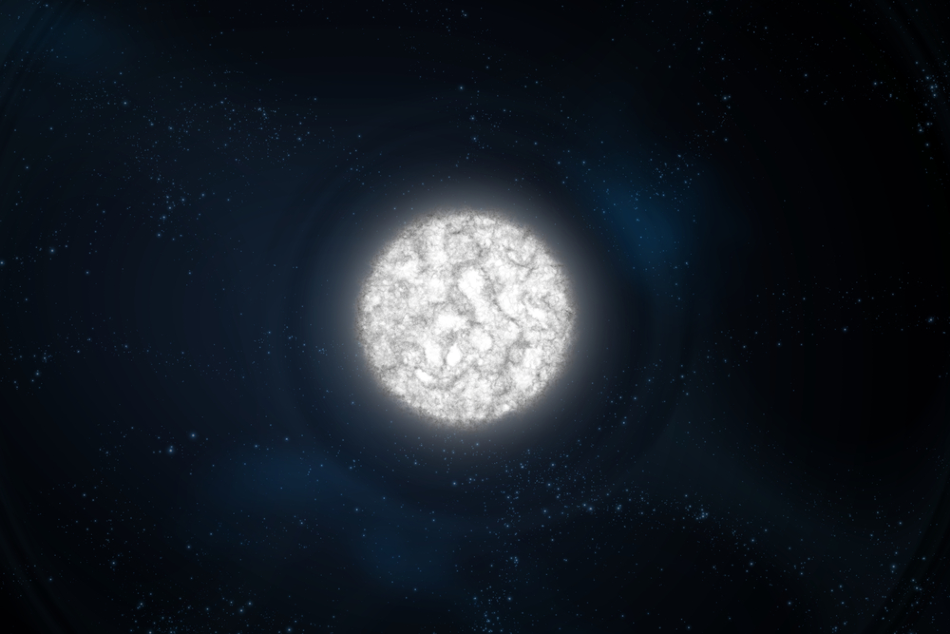
Image Credit: sciencepics/Shutterstock.com
Astronomers have discovered a massive white dwarf, 1.14 times the mass of our Sun, which they propose is the result of a merger between two smaller white dwarfs.
‘Massive white dwarf’ may sound like the ultimate oxymoron, but the discovery of such a star, tagged as WDJ0551+4135, at a distance of 150 light-years from Earth has forced astronomers to rethink both the evolution of white dwarfs and the distribution of supernovae throughout the universe.
White dwarfs are the stellar remnants of stars such as our sun which have completed the burning of hydrogen, often referred to as the main sequence of a star’s lifetime, and shed their outer layers revealing a core of degenerate-matter.
They tend to be small, around 0.6 solar masses, meaning that this example is just under twice the average size compressed into a radius of just two-thirds Earth’s diameter.
While WDJ0551+4135’s size alone may have sparked a rethink of white dwarf evolution, with that reanalysis leading to the suggestion of its origin as the result of a merger event, a team of astronomers led by Dr. Mark Hollands from the University of Warwick found additional evidence in the form of the chemical composition of the star.
WDJ0551+4135 was first identified in survey data collected by the European Space Agency’s (ESA) Gaia telescope. This sighting was followed by a spectroscopic examination conducted with the William Herschel Telescope.
In the spectroscopic examination, the light signature of the massive white dwarf was broken down to reveal its individual chemical constituents. In doing this the astronomers discovered that the massive white dwarf had a composition that was unusually rich in carbon. Normally with such white dwarfs, astronomers would expect to see an outer layer of hydrogen, or possibly a hydrogen and helium mixture, or simply a composition of just helium and carbon.
What is unexpected about this star is the mixture of carbon and hydrogen in the same layer with no separating layer of helium dividing them. Also, the total ratio of helium and hydrogen are several orders of magnitude lower than one would expect to see if the white dwarf had evolved as a single star.
This composition not only defies what we understand to be the normal evolution of a white dwarf or any single star, but there are clues about the white dwarf that suggest it is much older than its initial appearance suggests.
WDJ0551+4135 is Older Than It Looks
One of the major indicators of a star’s age is the speed at which it orbits through its host galaxy, with older stars moving faster than younger ones.
WDJ0551+4135 moves through the Milky Way 99% faster than the other white dwarfs in its vicinity, suggesting that it is older. The problem is that its cooling profile, the rate at which it loses heat, matches much younger white dwarfs. These seemingly conflicting characteristics point to a merger as the origin of the massive white dwarf.
While the daughter white dwarf retains the kinematic profile (its velocity traveling through the Milky Way) of the two stars that merged to create it, the merger also restarted its cooling - making it appear younger.
The fact that the merger restarted the cooling process means that it is difficult for researchers to pinpoint exactly how old WDJ0551+4135 actually is. Despite this, the cooling reset does allow them to approximately determine when the merger took place.
The team estimates that the merger took place 1.3 billion years ago, and there is more than a good chance that the white dwarfs that gave rise to it existed for billions of years prior to this.
The merger event that created WDJ0551+4135 would have begun with two stars orbiting each other in a binary system. The stars would likely have been of a similar size but eventually one of the stars, probably the more massive one, would have burned through all the fusible fuel within its core, causing its outer shell to expand and engulf its smaller partner. The second star’s orbit is then pulled closer as the bigger star contracts again.
This leads to a binary system with two stars in an incredibly tight orbit. Through processes such as the loss of gravitational energy through the emission of gravitational waves, the stars were destined to become even closer and eventually, merge.
Further Ramifications from the Discovery of WDJ0551+4135
The discovery of such a massive white dwarf star created by a merger process has interesting consequences for our understanding of supernovae. It is currently believed that the upper limit for merger events to create supernovae is around 1.4 solar masses. WDJ0551+4135 is tantalizingly close to this upper boundary and certainly gives scientists reason to suspect that limit can’t be much lower than 1.4 times the mass of our sun.
WDJ0551+4135 is one of only a handful of merger white dwarfs discovered so far by astronomers, and currently, it is the only one that has had its origins revealed by analysis of its composition.
The hope is that new techniques and the building of vastly improved telescopes will help scientists spot more of these objects. In addition to this, the rapidly growing field of astroseismology should help future astronomers determine just what lies within the cores of these stars.
References and Further Reading
Hollands. M, Tremblay. P. E, Gänsicke. B. T, et al, An ultra-massive white dwarf with a mixed hydrogen-carbon atmosphere as a likely merger remnant, Nature Astronomy, (2020), DOI: 10.1038/s41550–020–1028–0
Disclaimer: The views expressed here are those of the author expressed in their private capacity and do not necessarily represent the views of AZoM.com Limited T/A AZoNetwork the owner and operator of this website. This disclaimer forms part of the Terms and conditions of use of this website.